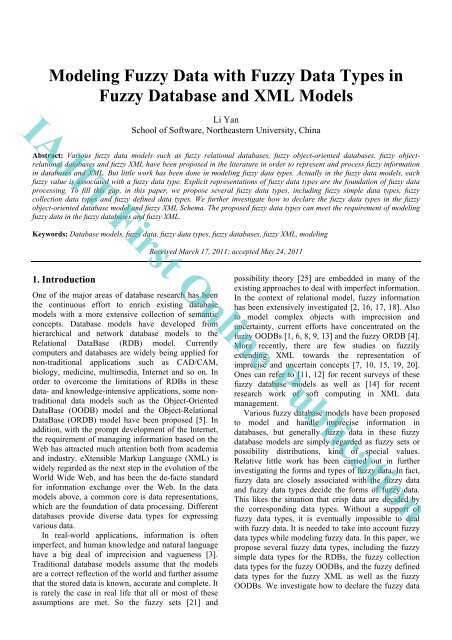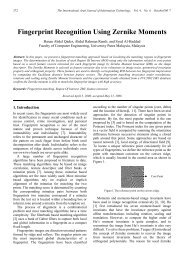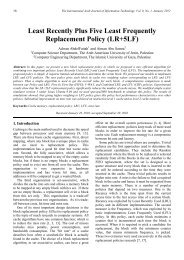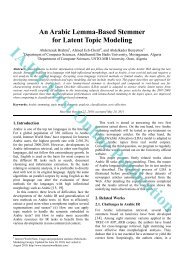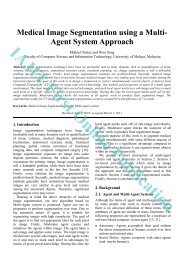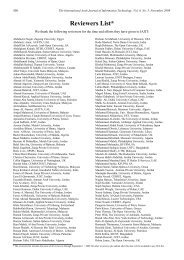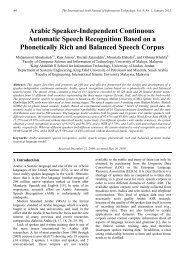IAJIT First Online Publication
IAJIT First Online Publication
IAJIT First Online Publication
Create successful ePaper yourself
Turn your PDF publications into a flip-book with our unique Google optimized e-Paper software.
Modeling Fuzzy Data with Fuzzy Data Types in<br />
Fuzzy Database and XML Models<br />
<strong>IAJIT</strong> <strong>First</strong> <strong>Online</strong> <strong>Publication</strong><br />
Li Yan<br />
School of Software, Northeastern University, China<br />
Abstract: Various fuzzy data models such as fuzzy relational databases, fuzzy object-oriented databases, fuzzy objectrelational<br />
databases and fuzzy XML have been proposed in the literature in order to represent and process fuzzy information<br />
in databases and XML. But little work has been done in modeling fuzzy data types. Actually in the fuzzy data models, each<br />
fuzzy value is associated with a fuzzy data type. Explicit representations of fuzzy data types are the foundation of fuzzy data<br />
processing. To fill this gap, in this paper, we propose several fuzzy data types, including fuzzy simple data types, fuzzy<br />
collection data types and fuzzy defined data types. We further investigate how to declare the fuzzy data types in the fuzzy<br />
object-oriented database model and fuzzy XML Schema. The proposed fuzzy data types can meet the requirement of modeling<br />
fuzzy data in the fuzzy databases and fuzzy XML.<br />
Keywords: Database models, fuzzy data, fuzzy data types, fuzzy databases, fuzzy XML, modeling<br />
1. Introduction<br />
One of the major areas of database research has been<br />
the continuous effort to enrich existing database<br />
models with a more extensive collection of semantic<br />
concepts. Database models have developed from<br />
hierarchical and network database models to the<br />
Relational DataBase (RDB) model. Currently<br />
computers and databases are widely being applied for<br />
non-traditional applications such as CAD/CAM,<br />
biology, medicine, multimedia, Internet and so on. In<br />
order to overcome the limitations of RDBs in these<br />
data- and knowledge-intensive applications, some nontraditional<br />
data models such as the Object-Oriented<br />
DataBase (OODB) model and the Object-Relational<br />
DataBase (ORDB) model have been proposed [5]. In<br />
addition, with the prompt development of the Internet,<br />
the requirement of managing information based on the<br />
Web has attracted much attention both from academia<br />
and industry. eXtensible Markup Language (XML) is<br />
widely regarded as the next step in the evolution of the<br />
World Wide Web, and has been the de-facto standard<br />
for information exchange over the Web. In the data<br />
models above, a common core is data representations,<br />
which are the foundation of data processing. Different<br />
databases provide diverse data types for expressing<br />
various data.<br />
In real-world applications, information is often<br />
imperfect, and human knowledge and natural language<br />
have a big deal of imprecision and vagueness [3].<br />
Traditional database models assume that the models<br />
are a correct reflection of the world and further assume<br />
that the stored data is known, accurate and complete. It<br />
is rarely the case in real life that all or most of these<br />
assumptions are met. So the fuzzy sets [21] and<br />
Received March 17, 2011; accepted May 24, 2011<br />
possibility theory [25] are embedded in many of the<br />
existing approaches to deal with imperfect information.<br />
In the context of relational model, fuzzy information<br />
has been extensively investigated [2, 16, 17, 18]. Also<br />
to model complex objects with imprecision and<br />
uncertainty, current efforts have concentrated on the<br />
fuzzy OODBs [1, 6, 8, 9, 13] and the fuzzy ORDB [4].<br />
More recently, there are few studies on fuzzily<br />
extending XML towards the representation of<br />
imprecise and uncertain concepts [7, 10, 15, 19, 20].<br />
Ones can refer to [11, 12] for recent surveys of these<br />
fuzzy database models as well as [14] for recent<br />
research work of soft computing in XML data<br />
management.<br />
Various fuzzy database models have been proposed<br />
to model and handle imprecise information in<br />
databases, but generally fuzzy data in these fuzzy<br />
database models are simply regarded as fuzzy sets or<br />
possibility distributions, kind of special values.<br />
Relative little work has been carried out in further<br />
investigating the forms and types of fuzzy data. In fact,<br />
fuzzy data are closely associated with the fuzzy data<br />
and fuzzy data types decide the forms of fuzzy data.<br />
This likes the situation that crisp data are decided by<br />
the corresponding data types. Without a support of<br />
fuzzy data types, it is eventually impossible to deal<br />
with fuzzy data. It is needed to take into account fuzzy<br />
data types while modeling fuzzy data. In this paper, we<br />
propose several fuzzy data types, including the fuzzy<br />
simple data types for the RDBs, the fuzzy collection<br />
data types for the fuzzy OODBs, and the fuzzy defined<br />
data types for the fuzzy XML as well as the fuzzy<br />
OODBs. We investigate how to declare the fuzzy data
types in the fuzzy OODB model and fuzzy XML<br />
Schema.<br />
The remainder of this paper is organized as follows.<br />
section 2 discusses the fuzzy sets and fuzzy data<br />
representations in the fuzzy databases. In section 3, the<br />
fuzzy data with fuzzy data types, including the fuzzy<br />
simple data types, fuzzy collection data types and the<br />
fuzzy defined data types, are discussed. Fuzzy data<br />
type modeling in fuzzy database and XML models is<br />
investigated in section 4. Section 5 concludes this<br />
paper.<br />
2. Fuzzy Sets And Fuzzy Data<br />
Representations<br />
Different models have been proposed to handle<br />
different categories of data quality (or the lack<br />
thereof). Many current approaches to imprecision and<br />
uncertainty are based on the theory of fuzzy sets [21].<br />
Let U be a universe of discourse and F be a fuzzy<br />
set in U. A membership function is defined for F as<br />
follows:<br />
� F: U � [0, 1] (1)<br />
Here �F (u) for each u � U denotes the membership<br />
degree of u in the fuzzy set F. Thus, the fuzzy set F is<br />
described with the equation 2:<br />
F = {( u 1, � F (u 1)), (u 2, � F (u 2)), ..., (u n, � F (u n))} (2)<br />
When the membership degree �F (u) above is<br />
explained to be a measure of the possibility that a<br />
variable X has the value u, where X takes values in U, a<br />
fuzzy value is described by a possibility distribution �X<br />
[25].<br />
� X = {(u 1, � X (u 1)), (u 2, � X (u 2)), ..., (u n, � X (u n)} (3)<br />
In the equation 3, �X (ui), ui � U denotes the possibility<br />
that ui is true. Let �X be the possibility distribution<br />
representation for the fuzzy value of a variable X. It<br />
means that the value of X is fuzzy, and X may take one<br />
from some possible values u1, u2, ..., and un and each<br />
one (say ui) taken possibly is associated with its<br />
possibility degree (say �X (ui)).<br />
Fuzzy sets and possibility theory have been used for<br />
extending database models. In the fuzzy database<br />
models, linguistic labels [22, 23, 24] are generally used<br />
to represent fuzzy data, for example, young, middleaged<br />
and old for people’s age. But the semantics of the<br />
linguistic labels are defined by using fuzzy sets or<br />
possibility distributions over a domain. Let us look at<br />
the example in Figure 1, in which three linguistic<br />
labels young, middle-aged and old are fuzzy values<br />
and their membership functions are defined over<br />
domain {0, 1, 2, 3, ..., 120}. Also these three<br />
membership functions can simply be expressed using<br />
(0, 0, 30, 45), (30, 45, 55, 65) and (55, 65, 120, 120),<br />
respectively.<br />
young middle-aged<br />
old<br />
<strong>IAJIT</strong> <strong>First</strong> <strong>Online</strong> <strong>Publication</strong><br />
1<br />
0<br />
30 45<br />
Figure 1. Representations of fuzzy age data.<br />
Each datum (or value) is associated with an attribute in<br />
the databases and with an element in XML. In the<br />
databases, for example, a value is an attribute values,<br />
and each attribute has a data type, which is used to<br />
represent a domain of instance values. The domain is a<br />
set of possible values associated with the attribute and<br />
the data type. Let A be an attribute with a given data<br />
type (say integer type), dom (A) denote the welldefined<br />
domain of attribute A, and ai be the value of<br />
attribute A. Then we have ai � dom (A) and ai must be<br />
a number of integer.<br />
In the context of fuzzy databases, attribute values<br />
may be fuzzy values. We call the attributes taking<br />
fuzzy values fuzzy attributes. A fuzzy attribute value<br />
should come from its attribute domain also, but this<br />
attribute domain contains a set of fuzzy subsets built<br />
over the classical attribute domain (called crisp<br />
attribute domain). This set of fuzzy subsets is called<br />
fuzzy attribute domain. So for a fuzzy attribute, its<br />
attribute domain should be the union of its crisp<br />
attribute domain and its fuzzy attribute domain [13].<br />
Formally let A be a fuzzy attribute and then we have:<br />
dom(A)= cdom (A) � fdom (A) (4)<br />
In the equation 4, cdom (A) and fdom (A) denote the<br />
crisp attribute domain and fuzzy attribute domain,<br />
respectively. For cdom (A), it is a set of {c1, c2, …, ck},<br />
where cl (1 � l � k) is a crisp value with a given data<br />
type. Similarly, fdom (A) = {f1, f2, …, fm} is a set of<br />
fuzzy subsets, where fj (1 � j � m) is a fuzzy value and<br />
defined over cdom (A). At this point, a value of<br />
attribute A may be a crisp value or a fuzzy value. So it<br />
can be declared that a fuzzy attribute must have a fuzzy<br />
data type, which underlying data type is the<br />
corresponding data type of the crisp attribute domain.<br />
For the fuzzy integer, for example, its underlying data<br />
type is integer.<br />
3. Fuzzy Data with Fuzzy Data Types<br />
In the classical databases, some simple data types such<br />
as integer and real are redefined and an attribute value<br />
can only be an atomic value with the given sample data<br />
type. In the OODBs, in addition to atomic value, an<br />
attribute value may be a complex value and so<br />
complex data types such as collection types are needed.<br />
55<br />
65
Also the defined data types are needed in the OODBs<br />
and XML Schema.<br />
Fuzziness may exist in the simple data types, the<br />
collection data types and the defined data types. Then<br />
we have fuzzy simple types, fuzzy collection types and<br />
fuzzy defined types.<br />
3.1. Fuzzy Simple Data Types<br />
Simple data types (also known as atomic data types)<br />
are the basic data types predefined by DataBase<br />
Management Systems (DBMSs) and XML Schema.<br />
The RDB model, OODB model and XML model<br />
(Schema) all contain the simple data types. Depending<br />
on different systems, there are different kinds of simple<br />
data types such as number data type, real data type,<br />
integer data type, Boolean data type, string data type,<br />
and so on. Basically we classify the simple data types<br />
into numerical data types and categorical data types.<br />
A fuzzy simple data type corresponds to a set of<br />
fuzzy subsets, which are defined over the<br />
corresponding simple data type. For a fuzzy numerical<br />
data type, it corresponds to a domain which is a set of<br />
fuzzy subsets of the universe integer or real numbers.<br />
These fuzzy subsets are generally represented by<br />
linguistic labels, which are defined with fuzzy sets or<br />
possibility distributions over the corresponding crisp<br />
numerical types.<br />
In the example of Figure 1, for example, Age has a<br />
fuzzy numerical data type, in which young, middleaged<br />
and old are defined over crisp numerical type.<br />
For a fuzzy categorical data type, it corresponds to a<br />
domain which is a set of fuzzy subsets of the universe<br />
strings. These fuzzy subsets may be represented by<br />
linguistic labels or directly by fuzzy sets or possibility<br />
distributions. If linguistic labels are used, they should<br />
be also defined with fuzzy sets or possibility<br />
distributions over the corresponding crisp data types.<br />
Let us look at an example. Suppose that we have a<br />
set of fuzzy subsets to represent fuzzy grades: {{(1.0,<br />
excellent), (1.0, very good), (1.0, good), (0.5, more or<br />
less good)}, {(0.5, more or less good), (1.0, common),<br />
(0.5, more or less bad)}, {(0.5, more or less bad), (1.0,<br />
bad), (1.0, very bad), (1.0, too bad)}}. In this set, a<br />
subset, say {(1.0, excellent), (1.0, very good), (1.0,<br />
good), (0.5, more or less good)}, is a possibility<br />
distribution, which is defined over {excellent, very<br />
good, good, more or less good, common, more or less<br />
bad, bad, very bad, too bad}.<br />
3.2. Fuzzy Collection Data Types<br />
Collection types are used to represent ordered or<br />
unordered collections, which may have fixed or<br />
variable sizes. In addition, collection types may allow<br />
duplicate or unduplicated collections. The underlying<br />
data types of collection data types can be simple types<br />
or even another collection types.<br />
When the fuzzy simple data types are used as the<br />
underlying data types of collection data types, we have<br />
fuzzy collection data types. So the fuzziness of a fuzzy<br />
collection data type comes from the fuzziness of its<br />
underlying data type.<br />
Suppose that we have a set value [very young,<br />
young, 32, more or less young] with fuzzy collection<br />
data type, which underlying data type is fuzzy<br />
numerical. Here two linguistic labels very young and<br />
more or less young are fuzzy values. Since very young<br />
and more or less young can be regarded as the<br />
modified (composite) fuzzy label of young, their<br />
membership functions can be computed through the<br />
membership function of young. Let the membership<br />
function of young be �young, then we have the<br />
followings:<br />
<strong>IAJIT</strong> <strong>First</strong> <strong>Online</strong> <strong>Publication</strong><br />
�very young (u) = (�young (u)) 2 (5)<br />
�more or less young (u) = (�young (u)) 1/2 (6)<br />
3.3. Fuzzy Defined Data Types<br />
Generally two kinds of the defined data types can be<br />
identified in databases and programming languages:<br />
the first one is called the reduced defined data type and<br />
the second one is called the aggregative defined data<br />
type. <strong>First</strong> let us look at the reduced defined data type.<br />
A reduced defined data type is formed by putting some<br />
constraints on the underlying data type, in which the<br />
underlying data type may be a simple type or a<br />
collection type. For the data type of integer, for<br />
example, we may define a reduced defined data type<br />
named MyInterger based on the data type of integer, in<br />
which we put a constraint 0 � MyInterger � 150 on the<br />
data type of integer.<br />
Formally, let B be an underlying data type and S be<br />
a reduced defined data type of B. It is clear that:<br />
dom (S) � dom (B) (7)<br />
In the equation 7, dom (S) and dom (B) are used to<br />
express the domains of S and B, respectively. Actually<br />
an underlying data type and its reduced defined data<br />
type has a relationship of supertype and subtype. Here<br />
the underlying data type is the supertype and the<br />
reduced defined data type is the subtype.<br />
Now let us look at the aggregative defined data type.<br />
An aggregative defined data type creates a type that<br />
defines the properties of real world or conceptual<br />
objects. The properties are mainly defined in terms of<br />
attributes, and each attribute have a value domain, i.e.,<br />
data type. We call these data types of the attributes in<br />
the aggregative defined data type as component data<br />
types. The component data types can be the sample<br />
data types, the collection data types and even other<br />
defined data types. For example, we may define an<br />
aggregative defined data type named Product, which<br />
contains four component data types: a categorical data
type for its property of ID and three real data types for<br />
its properties of length, width and height, respectively.<br />
Formally, let C be a component data type and A be<br />
an aggregative defined data type containing C. It is<br />
clear that:<br />
dom (C) � dom (A) (8)<br />
In the equation 8, dom (C) and dom (A) are used to<br />
express the domains of C and A, respectively. Actually<br />
the component data types and the corresponding<br />
aggregative defined data type have a relationship of<br />
aggregation (i.e., a whole-part relationship). Here the<br />
component data types are the constituent parts and the<br />
reduced defined data type is the aggregate.<br />
Corresponding to two kinds of the defined data<br />
types, we have two kinds of fuzzy defined data types,<br />
which are the fuzzy reduced defined data type and the<br />
fuzzy aggregative defined data type. The fuzziness of a<br />
reduced defined data type comes from that of its<br />
underlying data type. Suppose we have a fuzzy data<br />
type FuzzyInteger, and we may define a fuzzy reduced<br />
defined data type named MyFuzzyInterger based on<br />
the data type of FuzzyInteger.<br />
The fuzziness of an aggregative defined data type<br />
comes from that of its component data types. We know<br />
that an attribute in an aggregative defined data type<br />
defines a value domain. When this domain is a set of<br />
fuzzy subset, the fuzziness of an attribute value<br />
appears. Still let us look at the aggregative defined data<br />
type Product above. Suppose that three component data<br />
types for its properties of length, width and height are<br />
fuzzy real data types. At this point, the aggregative<br />
defined data type Product above becomes a fuzzy<br />
aggregative defined data type.<br />
4. Fuzzy Data Type Declarations<br />
When we model fuzzy data in databases models and<br />
XML models, it is necessary to explicitly declare the<br />
data types of fuzzy data so that the fuzzy data can be<br />
dealt with in right ways. In the following, we present<br />
how to declare the fuzzy data types in the fuzzy<br />
database models and fuzzy XML model, respectively.<br />
Since the fuzzy RDBs only contains the simple data<br />
types (crisp or fuzzy), we here concentrate on the fuzzy<br />
OODB model.<br />
4.1. Fuzzy Data Type Declaration in Fuzzy<br />
Object-Oriented Database Model<br />
The core of the fuzzy OODB model is the nation of<br />
fuzzy class [13]. The specification of a fuzzy class<br />
includes the definition of ISA relationships, attributes<br />
and method implementations. Some additional<br />
definitions are needed to specify a fuzzy class. <strong>First</strong>,<br />
weights must be assigned to the attributes of the class.<br />
In addition to these common attributes, a new attribute<br />
should be added to the class to indicate the<br />
membership degree to which an object belongs to the<br />
class. If a class is a fuzzy subclass, its superclasses and<br />
the degree to which the class is the subclass of the<br />
superclasses should also be illustrated in the<br />
specification of the class. Finally, in the definition of a<br />
fuzzy class, fuzzy attributes are explicitly indicated and<br />
their data types are declared.<br />
For the fuzzy attributes of fuzzy classes, the data<br />
types are fuzzy data types based simple data types or<br />
collection data types, which allows the representation<br />
of descriptive form of imprecise information. Only<br />
fuzzy attributes have fuzzy type and fuzzy attributes<br />
are explicitly indicated in a fuzzy database model<br />
definition. Therefore, in the definition, we declare only<br />
the underlying data type (e.g., integer) of fuzzy<br />
attributes and the fuzzy domain. A fuzzy domain is a<br />
set of possibility distributions or fuzzy linguistic terms<br />
(each fuzzy term is associated with a membership<br />
function).<br />
For example, a fuzzy attribute Age is declared as<br />
follows:<br />
<strong>IAJIT</strong> <strong>First</strong> <strong>Online</strong> <strong>Publication</strong><br />
Age: FUZZY DOMAIN {very young, young, old, very<br />
old}: TYPE OF integer<br />
Then an object attribute defined fuzzy type will have<br />
either a crisp value or a fuzzy value given in the type<br />
definition. For example, Age = 21 or Age = young.<br />
4.2. Fuzzy Data Type Declaration in Fuzzy<br />
XML Model<br />
Compared with XML Document Type Definition<br />
(DTD), XML Schema can support rich data types. In<br />
[10], fuzzy XML DTD is proposed for fuzzy<br />
information modeling. Fuzzy XML Schema is<br />
investigated in [20] with a focus on the fuzziness of<br />
XML document contents. That is the fuzziness of<br />
elements and the fuzziness of attribute values in<br />
elements. In the following, we discuss the fuzzy data<br />
types in the fuzzy XML Schema.<br />
XML Schema supports two kinds of different data<br />
types: the simple data types and the complex data types<br />
based on the sample data types. The sample data types<br />
are further divided into two categories: the first one is<br />
the built-in data types provided by the XML Schema<br />
(e.g., numerical, integer, real and string), which can<br />
directly be used in the declarations of elements and<br />
attributes, the other one is the defined sample data<br />
types, which are defined on the basis of the underlying<br />
data types by users using the simpleType structure.<br />
Here the underlying data types may be the built-in data<br />
types or the defined simple data types. In the XML<br />
Schema, the simpleType supports three kinds of<br />
mechanisms to define new simple data types from the<br />
underlying data types, which are restriction, list and<br />
union. Such mechanisms in the XML Schema provide<br />
a natural and effective method to define the fuzzy data<br />
types. Since the complex data types are created by the
simple data types, here we only discuss the simple data<br />
types of fuzzy element values in the XML Schema.<br />
For the fuzzy values of elements, their data types<br />
are the fuzzy sample data types, in which the<br />
representations of imprecise and uncertain information<br />
are allowed. Only fuzzy elements have fuzzy data<br />
types, which need to be explicitly indicated in the<br />
XML Schema. For this purpose, in addition that the<br />
element is declared to be a fuzzy element, like what we<br />
do in the above, it is needed to declare the fuzzy<br />
domain of the fuzzy element. A fuzzy domain is a set<br />
of possibility distributions or fuzzy linguistic terms, in<br />
which each term is associated with a membership<br />
function, and must be based on an underlying data type<br />
(i.e., integer). A fuzzy domain can be defined using the<br />
structure of simpleType in XML Schema.<br />
Let us look at a fuzzy element Age. Suppose that its<br />
fuzzy domain is {very young, young, old, very old}<br />
based on integer data type, and this integer data type<br />
has a constraint of being greater than or equal to 0<br />
and less than or equal to 150. <strong>First</strong>, we define an<br />
integer data type named AgeInteger, which meets the<br />
constrain of being greater than or equal to 0 and less<br />
than or equal to 150.<br />
<br />
<br />
<br />
< xsd:maxExclusive value =”150”/><br />
<br />
Based on integer data type AgeInteger defined above, a<br />
fuzzy integer data type named FuzzAgeInteger is<br />
constructed using the membership functions of the<br />
fuzzy terms. A value of the fuzzy integer data type<br />
FuzzAgeInteger is a set, in which each element is a pair<br />
of data with form say (20, 0.8), being consisted of the<br />
values of integer data type AgeInteger and the<br />
corresponding membership degrees. This set is actually<br />
a fuzzy set with a semantic interpretation of possibility<br />
distribution, and formally is represented with a<br />
linguistic term (say young). It should especially<br />
pointed out that fuzzy integer data type FuzzAgeInteger<br />
is not a restricted form of integer data type AgeInteger,<br />
but an extended data type based on AgeInteger, which<br />
underlying data type is AgeInteger. Since current XML<br />
Schema can only put restrictions on the underlying<br />
data types when it supports users to define simple data<br />
types, and cannot extend the value space of data types.<br />
So fuzzy integer data type FuzzAgeInteger cannot be<br />
defined directly by XML Schema. In real-world<br />
applications, it is very useful to construct new simple<br />
data types with several underlying data types by means<br />
of expanding the value spaces of data types. Current<br />
version of XML fails to do that. For the complex data<br />
types, the focus of XML Schema is on defining its<br />
complex structures, not on defining the value spaces of<br />
the complex data types.<br />
With fuzzy integer data type FuzzAgeInteger, the<br />
fuzzy domain of FuzzAgeInteger is declared as follows:<br />
<br />
<br />
<br />
<br />
<br />
<br />
<br />
<strong>IAJIT</strong> <strong>First</strong> <strong>Online</strong> <strong>Publication</strong><br />
Since the value of a fuzzy element may take a crisp or<br />
fuzzy value, the data type of fuzzy element Age can be<br />
declared with the following union type:<br />
<br />
<br />
<br />
Finally fuzzy element Age is declared as follows:<br />
<br />
Its corresponding value may be a crisp value (say<br />
Age= 21) or a fuzzy value (say Age= young).<br />
It can be seen from the above example that XML<br />
Schema provides a flexible mechanism for defining<br />
diverse data types. This mechanism is very useful for<br />
representing fuzzy data. In the above, we use an<br />
example of defining a fuzzy integer to demonstrate the<br />
procedure of declaring fuzzy data types. Following a<br />
similar way, we can declare other fuzzy data types.<br />
5. Conclusions<br />
In the real world, human knowledge and natural<br />
language have a big deal of imprecision and vagueness.<br />
Fuzzy technologies have been extensively used for<br />
intelligent data processing and intelligent systems.<br />
Various fuzzy data models such as fuzzy RDBs, fuzzy<br />
OODBs, fuzzy ORDBs and fuzzy XML have been<br />
proposed to represent and process fuzzy information in<br />
databases and XML. Despite fuzzy data has been<br />
employed to model and handle imprecise information<br />
in data models since the theory of fuzzy sets was<br />
introduced, relative little work has been carried out in<br />
further investigating the types of fuzzy data towards<br />
the representation and processing of fuzzy data.<br />
In this paper, we focus on modeling fuzzy data with<br />
fuzzy data types in the fuzzy databases and fuzzy XML.<br />
We identify several fuzzy data types, including fuzzy<br />
simple data types, fuzzy collection data types and<br />
fuzzy defined data types. For the purpose of<br />
representing and processing fuzzy data, we elaborate<br />
the explicit declarations of the fuzzy data types in the<br />
fuzzy OODB model and fuzzy XML Schema,<br />
respectively. In future work, we will develop<br />
prototypes of fuzzy OODB system and fuzzy XML<br />
database system, and then complete the evaluation<br />
experiment of fuzzy data type modeling. Also we will
investigate how to query the fuzzy databases and fuzzy<br />
XML with fuzzy data types.<br />
Acknowledgment<br />
The work is supported by the National Natural Science<br />
Foundation of China (60873010, 61073139) and the<br />
Fundamental Research Funds for the Central<br />
Universities (N090504005 and N090604012).<br />
References<br />
[1] Bordogna G., Pasi G., and Lucarella D., "A<br />
Fuzzy Object-Oriented Data Model for Managing<br />
Vague and Uncertain Information", International<br />
Journal of Intelligent Systems, vol. 14, no. 7, pp.<br />
623-651, 1999.<br />
[2] Buckles B. P. and Petry F. E., "A Fuzzy<br />
Representation of Data for Relational Database",<br />
Fuzzy Sets and Systems, vol. 7, no. 3, pp. 213-<br />
226, 1982.<br />
[3] Chelliah M., Sankaran S., Prasad S., Gopalan N.<br />
and Sivaselvan B., "Routing for Wireless Mesh<br />
Networks with Multiple Constraints Using Fuzzy<br />
Logic", The International Arab Journal of<br />
Information Technology, vol. 9, no. 1, pp. 1-8,<br />
2011.<br />
[4] Cuevasa L., Marínb N., Ponsb O. and Vilab M.<br />
A., "pg4DB: A Fuzzy Object-Relational System",<br />
Fuzzy Sets and Systems, vol. 159, no. 12, pp.<br />
1500-1514, 2008.<br />
[5] Dietrich S. W. and Urban S. D., Fundamentals of<br />
Object Databases: Object-Oriented and Object-<br />
Relational Design, Morgan & Claypool<br />
[6]<br />
Publishers, San Rafael, USA, 2010.<br />
Dubois D., Prade H. and Rossazza J. P.,<br />
"Vagueness, Typicality, and Uncertainty in Class<br />
Hierarchies", International Journal of Intelligent<br />
Systems, vol. 6, no. 2, pp. 167-183, 1991.<br />
[7] Gaurav A. and Alhajj R., "Incorporating<br />
Fuzziness in XML and Mapping Fuzzy<br />
Relational Data into Fuzzy XML", in<br />
[8]<br />
Proceedings of the 2006 ACM Symposium on<br />
Applied Computing, Dijon, France, pp. 456-460,<br />
2006.<br />
George R., Srikanth R., Petry F. E. and Buckles<br />
B. P., "Uncertainty Management Issues in the<br />
Object-Oriented Data Model", IEEE<br />
[9]<br />
Transactions on Fuzzy Systems, vol. 4, no. 2, pp.<br />
179-192, 1996.<br />
Gyseghem N. V. and de Caluwe R., "Imprecision<br />
and Uncertainty in UFO Database Model",<br />
Journal of the American Society for Information<br />
Science, vol. 49, no. 3, pp. 236-252, 1998.<br />
[10] Ma Z. M. and Yan L., "Fuzzy XML Data<br />
Modeling with the UML and Relational Data<br />
Models", Data & Knowledge Engineering, vol.<br />
63, no. 3, pp. 972-996, 2007.<br />
[11] Ma Z. M. and Yan L., "A Literature Overview of<br />
Fuzzy Database Models", Journal of Information<br />
Science and Engineering, vol. 24, no. 1, pp. 189-<br />
202, 2008.<br />
[12] Ma Z. M. and Yan L., "A Literature Overview of<br />
Fuzzy Conceptual Data Modeling", Journal of<br />
Information Science and Engineering, vol. 26,<br />
no. 2, pp. 427-441, 2010.<br />
[13] Ma Z. M., Zhang W. J. and Ma W. Y.,<br />
"Extending Object-Oriented Databases for Fuzzy<br />
Information Modeling", Information Systems,<br />
vol. 29, no. 5, pp. 421-435, 2004.<br />
[14] Ma Z. M. and Yan L., Soft Computing in XML<br />
Data Management, Springer-Verlag, Heidelberg,<br />
Germany, 2010.<br />
[15] Oliboni B. and Pozzani G., "Representing Fuzzy<br />
Information by Using XML Schema", in<br />
Proceedings of the 19th International Workshop<br />
on Database and Expert Systems Application,<br />
Turin, Italy, pp. 683-687, 2008.<br />
[16] Prade H. and Testemale C., "Generalizing<br />
Database Relational Algebra for the Treatment of<br />
Incomplete or Uncertain Information and Vague<br />
Queries", Information Sciences, vol. 34, no. 2,<br />
pp. 115-143, 1984.<br />
[17] Raju K. V. S. V. N. and Majumdar K., "Fuzzy<br />
Functional Dependencies and Lossless Join<br />
Decomposition of Fuzzy Relational Database<br />
Systems", ACM Transactions on Database<br />
Systems, vol. 13, no. 2, pp. 129-166, 1988.<br />
[18] Umano M. and Fukami S., "Fuzzy Relational<br />
Algebra for Possibility-Distribution-Fuzzy-<br />
Relational Model of Fuzzy Data", Journal of<br />
Intelligent Information Systems, vol. 3, no. 1, pp.<br />
7-27, 1994.<br />
[19] Üstünkaya E., Yazici A. and George R., "Fuzzy<br />
Data Representation and Querying in XML<br />
Database", International Journal of Uncertainty,<br />
Fuzziness and Knowledge-Based Systems, vol.<br />
15, no. Supplement-1, pp. 43-57, 2007.<br />
[20] Yan L., Ma Z. M. and Liu J., "Fuzzy Data<br />
Modeling Based on XML Schema", in<br />
Proceedings of the 2009 ACM International<br />
Symposium on Applied Computing, Honolulu,<br />
Hawaii, USA, pp. 1563-1567, 2009.<br />
[21] Zadeh L. A., "Fuzzy Sets", Information and<br />
Control, vol. 8, no. 3, pp. 338-353, 1965.<br />
[22] Zadeh L. A., "The Concept of Linguistic<br />
Variable and Its Application to Approximate<br />
Reasoning I", Information Sciences, vol. 8, no. 3,<br />
pp. 199-251, 1975.<br />
[23] Zadeh L. A., "The Concept of Linguistic<br />
Variable and Its Application to Approximate<br />
Reasoning II", Information Sciences, vol. 8, no.<br />
4, pp. 301-357, 1975.<br />
[24] Zadeh L. A., "The Concept of Linguistic<br />
Variable and Its Application to Approximate<br />
<strong>IAJIT</strong> <strong>First</strong> <strong>Online</strong> <strong>Publication</strong>
Reasoning III", Information Sciences, vol. 9, no.<br />
1, pp. 43-80, 1975.<br />
[25] Zadeh L. A., "Fuzzy Sets as a Basis for a Theory<br />
of Possibility", Fuzzy Sets and Systems, vol. 1,<br />
no. 1, pp. 3-28, 1978.<br />
Li Yan received her Ph.D. degree<br />
from Northeastern University,<br />
China. She is currently an associate<br />
professor at Northeastern University,<br />
China. Her research interests include<br />
database modeling, XML data<br />
management, as well as imprecise<br />
and uncertain data processing. She has published some<br />
papers international journals such as Information<br />
Systems Frontiers, International Journal of Intelligent<br />
Systems and Integrated Computer-Aided Engineering.<br />
She has also published several edited books with<br />
Springer and IGI Global.<br />
<strong>IAJIT</strong> <strong>First</strong> <strong>Online</strong> <strong>Publication</strong>


